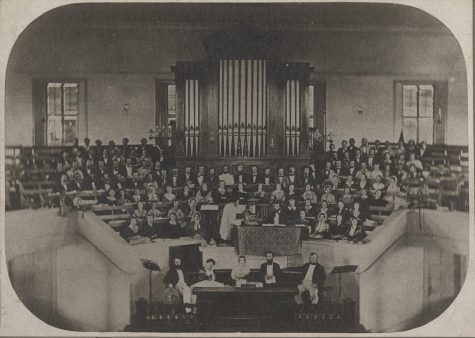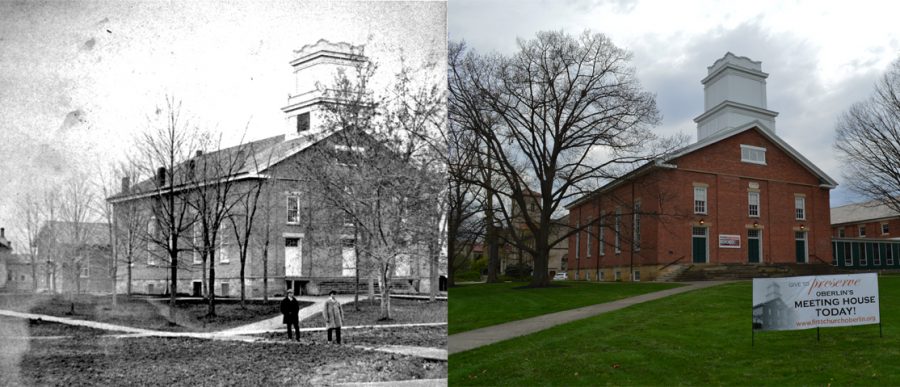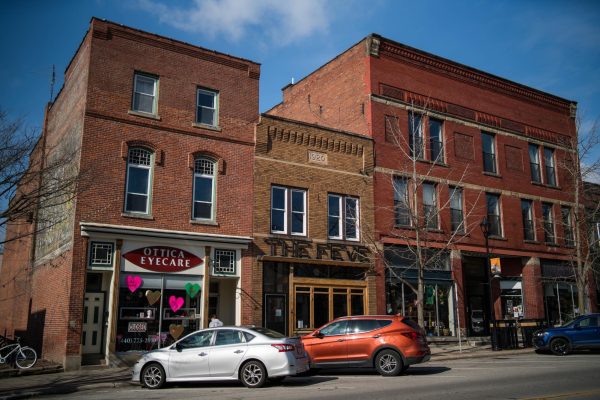First Church to Undergo Historic Renovations
Left photo courtesy of Laurel Price Jones, right photo by Juliette Greene
The First Church in Oberlin, United Church of Christ, in 1870, and the same building in 2019, almost 150 years later.
Members of The First Church in Oberlin, United Church of Christ believe it’s time to renovate the historic building that was completed in 1844. The renovations, which include window replacements, more accessible entryways, repointing old bricks, and a new elevator, and will cost the church around $1.45 million.
First Church has already raised around $300,000 in grants and $500,000 in donations, as well as $350,000 that the church already had on hand. This means they only need to raise $300,000 more. Co-chair of the fundraising campaign Laurel Price Jones says it is crucial that First Church is preserved.
“It is Oberlin’s most historic building,” said Price Jones. “There’s really no other building that you could say has the history of Oberlin so captured in one place.”

First Church’s 1859 choir poses for a photo in the church’s Meeting House, which is currently in the process of being renovated to preserve its historical character.
Bill Barlow, Price Jones’ co-chair, said the most important renovations will occur in the Meeting House, which will cost $800,000.
“The Meeting House has played a significant role in the history of the College and community,” Barlow wrote in an email to the Review. “In the 19th century it was the place that gatherings, performances, lectures, community meetings, etc. took place. It’s where many of the most important decisions impacting the town and College were debated for the first 80 years of Oberlin’s history, and it continues to fill the role of a community gathering place to this day.”
These renovations to the Meeting House include fixing the huge triple-paned windows, which were constructed by hand in 1842 and are now fixed shut and less energy-efficient than they could be. In addition, the church plans to replace the green velvet pew cushions, which have not been replaced since 1908, and to add an accessible ramp to the pulpit.
“When it was built, it was the largest auditorium west of the Alleghenies — imagine a town that’s less than 10 years old building the largest auditorium between New York and Chicago,” Price Jones said about the Meeting House. “That’s why you end up in this Meeting House having people like Frederick Douglass come to speak. The list of people who’ve spoken in this Meeting House — it’s just huge.”
Other renovations outside of the Meeting House include repointing the bricks and mortar around the exterior of the church, adding a terrace with accessible ramps for entry to the church, recarpeting, redoing bathrooms, adding a small elevator, and adding a foundation for the exterior steps that are starting to sag.
“For me, it’s exciting to think about the new staging in the sanctuary and how that will hearken back to the original design of the Meeting House,” Barlow wrote. “I’m excited about the new patio being planned for the west side of the church, and I’m pleased with everything we are doing to make all the First Church facilities more accessible to our entire community.”
The plans for the renovations started several years ago and involved input from a lot of different places, according to architect David Thal of Weber Murphy Fox.
“We were invited by the First Church in Oberlin to participate in a design charrette where we engaged with the congregation, Partners for Sacred Places, and the community to identify and develop ideas for a master plan,” Thal said. “There have been a lot of really exciting and thoughtful phases of this project.”
Beyond grants from the state of Ohio as well as the National Fund for Sacred Places, raising money for the renovations was very community-oriented.
“A lot of individuals in Oberlin say, ‘Well yeah, I don’t go to that church, but I wouldn’t want anything to happen to that building,’” Price Jones said.

Before First Church was built, Charles Finney’s congregation met each week in a huge tent headlined by blue banner that read “Holiness to the Lord.”
She added that this is reminiscent of the way that it was first built, almost 200 years ago.
“People gave everything — they gave the bricks, they gave the lumber, they were the workers, they gave money, somebody gave a top hat and it was sold, somebody gave a wagon,” Price Jones said. “The pews are made of black walnut. [The wood] was given by one man [who was] saving it to build himself a house. And he said, ‘Well, church comes first.’ So he gave all the black walnut that he’d saved for his own house, and he went on living in a log cabin.”
In addition to church services, about a hundred other organizations use First Church’s building, according to Price Jones. This includes organizations like Oberlin Community Services, Mad Factory Drama School, Alcoholics Anonymous, and Oberlin Choristers. In addition, First Church has been involved in the Oberlin community since the beginning of the town.
“Oberlin was founded in 1833 and it was essentially a utopian community of Christians who wanted to ‘save the perishing world,’” Price Jones said. “Within nine months, they started a college and they admitted men and women. The idea was that these men and women were going to be educated and then they were going to fan out around the United States and make the world a better place.”
First Church continues to be a place of community for many and the tradition of generosity and cooperative organization continues to this day.
“We are very pleased with the generosity of donors to this point, but [we] still need many more people to help us reach our final goal,” wrote Barlow.
Anyone interested in contributing can contact Price Jones or Barlow at (440) 775-1711.







